It has been almost a decade since Rangers won the Scottish Premier League with their Glasgow rivals Celtic taking all nine titles in that timeframe. As a result of Rangers’ financial disaster in 2011, they have endured seasons in the second and third tier of Scottish football. Since going into administration in 2011, Rangers have also had nine different managers. However, since Steven Gerrard’s appointment on June 1, 2018 Rangers look to be on the right path once more. Although Gerrard has not been able to deliver a trophy yet, his team looks like a side that is getting closer and closer to Celtic each year and this year may just be the one when they cross the line and stop the elusive 10 in a row.
This data analysis will look at the reasons why Rangers could finish above Celtic and secure the first league title in a decade. Through a closer look at Gerrard’s tactical changes and new signings, we will look at how Rangers are improving and the potential to secure points in the league.
A flexible 4-3-3
A key part of Rangers’ improvement under Gerrard has been the building of a tactical identity through his preferred 4-3-3 formation. When Gerrard first came to Rangers, it was a system that required two natural wingers on either side of talisman Alfredo Morelos. However, there have been variations and experimentations with other formations as Gerrard looks to find a formula that can beat Celtic. This is balanced with also finding a system that can break down the other teams in the division who like to play a low block against the Gers.
In the first season of the former Liverpool man, Rangers beat Celtic 1-0 at the end of 2018 to move level on points with Celtic after 21 games. This was done by playing a 4-2-3-1 that was able to stifle Celtic’s build-up play and nullify their attacking threats. Yet, as the season went on Rangers experienced problems with breaking down the low block and found creativity to be a real problem. Therefore, Gerrard reverted to the 4-3-3, but this time there were some alterations. Instead of playing with two natural wingers, Gerrard decided that the two wide players in the front three would act as number 10s to penetrate the half spaces in between the defence and midfield. This switch in 4-3-3 system coincided with an upturn in form as Rangers won six out of their last seven games to cement the formation as Gerrard’s primary system.
Even if there was an upturn in the performance levels for Rangers in the 2019/20 season, they were unable to keep pace with Celtic once more and wobbled considerably after the winter break as in the 2018/19 season. Therefore, there are two clear problems for Rangers to address. They are the ability to grind out results and break down the low block, alongside addressing the post-winter break struggles, which have derailed the last two seasons. Ultimately, these problems are deeper than Gerrard’s 4-3-3 system and the ways to improve and some promising early season signs will be discussed in the remainder of this piece.
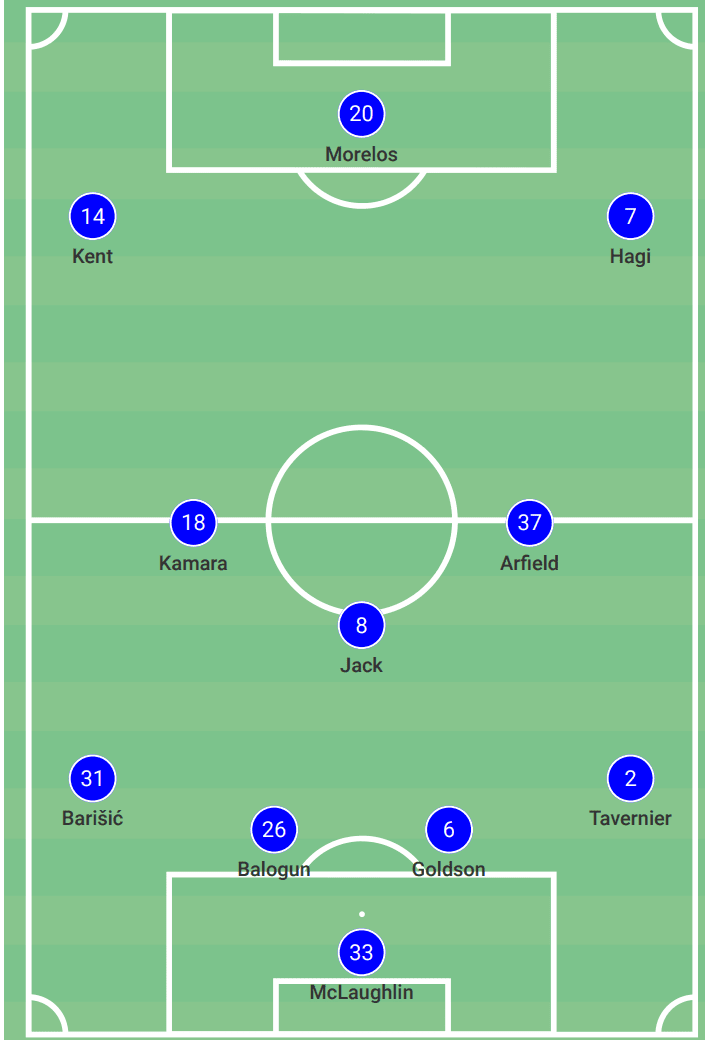
In the five games played so far this season, Rangers’ most common line-up has been the 4-3-3 with slight changes in personnel. Jon McLaughlin has been in goal ahead of the injured Allan McGregor and Leon Balogun, who was a free agent from Wigan, has come in alongside Connor Goldson. Joe Aribo has also played three out of the five matches as he has been rotated with Scott Arfield in a midfield three that has often shuffled around. Gerrard’s 4-3-3 is extremely flexible with the strong and skilful Aribo even slotting into the number 10 role on a couple of occasions to form a 4-2-3-1, but it is just another variation of his 4-3-3 with the two wide men playing as inside forwards.
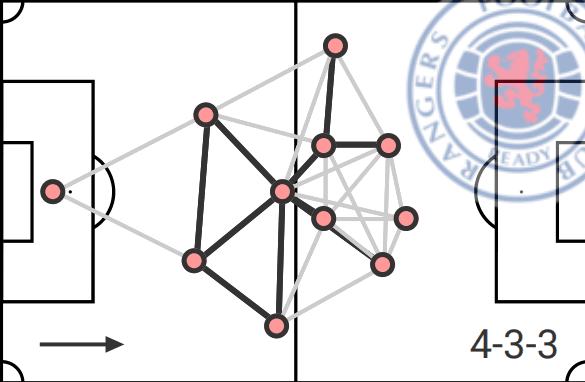
The graphic below is another indication of the flexible positional rotations that is the hallmark of Gerrard’s 4-3-3. While the front three and midfield three look to find overloads centrally, the full-backs of Borna Barisic and James Tavernier look to play high and wide so that the ball out wide is always an option. They can play this high as well because of the positioning of Ryan Jack and Glen Kamara who offer the defensive screen for Goldson and Balogun, who are both extremely hard to get past as a result of their pace and strength.
Problems with creativity and the low block
As already mentioned, Rangers have had a huge problem playing against deep defences in the past two seasons. When the initiative is placed on Rangers to break down these defences they struggle for fluidity and to create chances. Gerrard’s side have a lot of pace on the counterattack when they are allowed the space to play into. They were very successful in Europe this year, getting to the Europa League last 16. However, in the league the usual defensive structure Gerrard’s side come up against is a 4-5-1, which is the most effective low block to stifle Rangers’ attacking players. Ultimately, a huge part of Rangers’ problem has been pedestrian passing from the midfield three and a lack of creativity from the two number 10’s on a regular basis. A comparative analysis of the data from Rangers’ 2019/20 squad compared with their squad this season can help us see how Gerrard is looking to overcome the main issue that is holding his team back. As Gerrard is adapting as a manager, he will have to find the solutions to overcome this problem as it is something Rangers face very often in the league, and the early season signs are promising.
A big part of Rangers’ problems last season when trying to break down the low block was their conservative midfield three. The most common midfield was Steven Davis, Kamara and Jack with the likes of Kent, Aribo and Hagi ahead of them in the number 10 roles making it a 4-3-2-1. A breakdown of the most common midfield three is noteworthy given Rangers’ lack of spark and attacking flair in the latter part of the season.
As you can see from the graph below, Davis boasts the best attacking figures and he was the deepest midfielder of the three. The fact that the player who is designated to screen the back four and provide protection has more progressive passes per 90 than the other two is a worrying sign. Jack and Kamara have their benefits of course and are extremely hard working, which was a big reason for their counter-attacking successes in their European campaign. Yet as a pair against a low block they are not always the most functional. Ultimately, this midfield three severely lacked a ball carrier from deep to create space for the front three. Many times, Davis, Jack and Kamara were unable to penetrate the lines and find the half spaces for Aribo, Kent and Hagi to drive at the opposition defence. Instead, a lot of the games were played in front of many teams with no fear of the ball going in behind them, meaning they could closely marshal the number 10s to stop any attacking moves progressing.
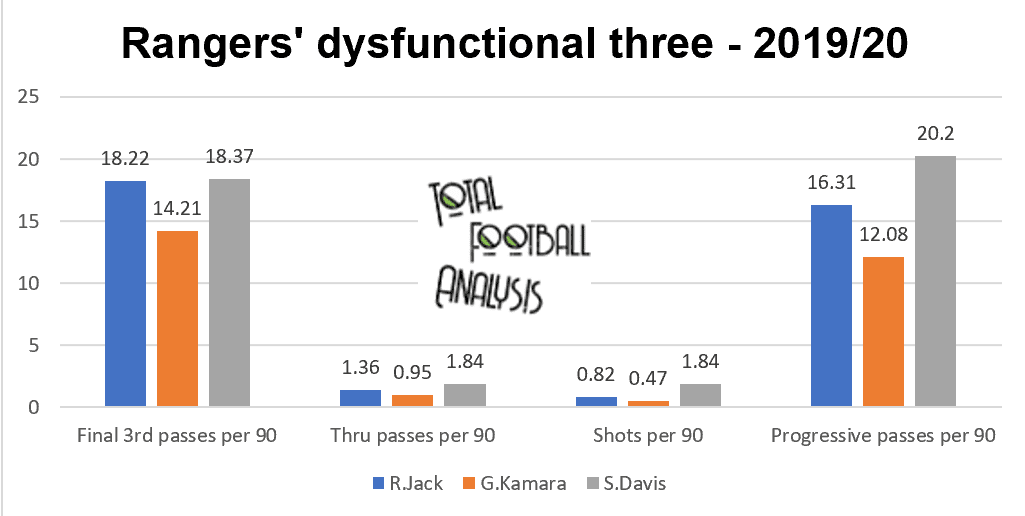
Are they adapting to these problems?
However, Gerrard has made subtle formation tweaks and personnel changes to ensure that Rangers have a more attacking threat from deeper. Perhaps the most encouraging managerial progression from Gerrard this season so far is that he has been willing to change and be more adaptable. Last season, he was criticised for rigidly sticking to a midfield combination and formation that didn’t work after the winter break. An example of that this season was the huge changes made after their frustrating 0-0 draw away at Livingston (their only dropped points of the season so far).
In this game, Gerrard started with a midfield three of Jack, Kamara and Scot Arfield who is very similar to Davis. He is a midfielder that provides more off the ball than on it. Similar frustrations ensued as Rangers couldn’t make their way through a solid Livingston side as they struggled to create chances throughout. In the very next game, Rangers beat Kilmarnock 2-0 at home with wholesale changes positionally and tactically. Gerrard switched to a 4-2-3-1 with Brandon Barker occupying the number 10 role and Davis coming in for Kamara. Up front, Kemar Roofe came in for Morelos alongside another new signing Cedric Itten.
Not only had Gerrard abandoned a three-man midfield but also played Itten, who is naturally a striker, as an inside forward to overload their opposition centrally. Itten often played alongside Roofe in attacking build-ups to make it more of a fluid 4-2-4 as Barker drifted wide throughout. Roofe is also a striker who likes to drop deeper and link the play, with Kent playing the roaming role where his remit was to disrupt the defensive shape of Kilmarnock by changing his position all over the pitch constantly. Rangers were frustrated in the first half, but the second-half performance was one that they completely dominated with Roofe scoring the opening goal. However, the most important thing was that Gerrard adapted and, in contrast, this was a stumbling block for him and the team at the end of last season.
Further evidence of Rangers’ improvement against the low block this season so far is their data for progressive passes and deep completions. The meaning of a progressive pass is a forward pass that is 30m long when the pass starts in the team’s own half, or a pass that is at least 10m length in the opponents half. In terms of a deep completion, this is when a non-cross pass is targeted to the central zone of the pitch within 20m of the opponent’s goal. Rangers are clear of their Glasgow rivals Celtic in both categories. Although Celtic have only played three games, the early season signs are encouraging as Rangers lacked a cutting edge and were behind Celtic by a distance in both categories last season.
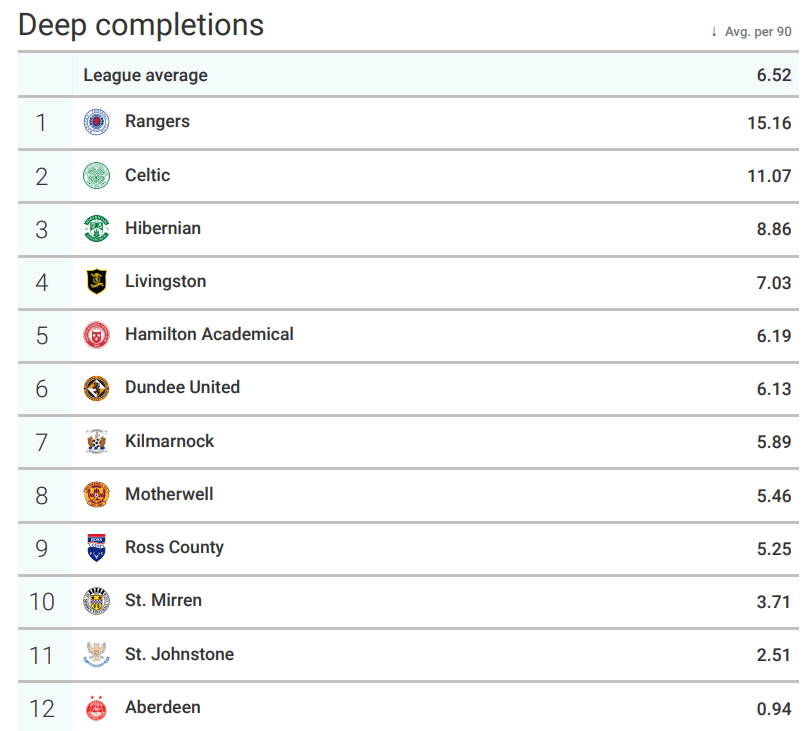
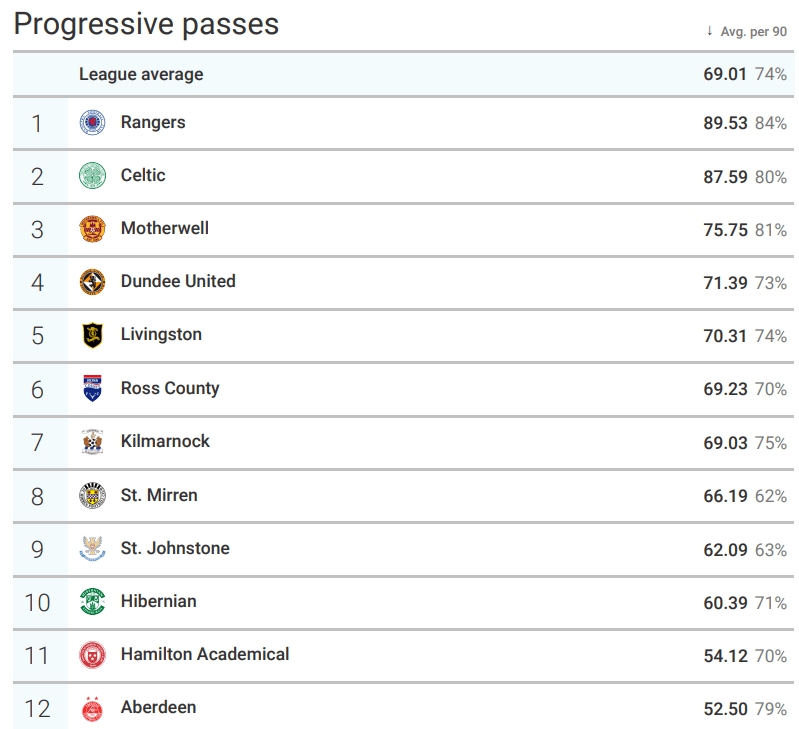
The importance of Aribo
Aribo will also have a key role to play in the system when he returns from injury. The former Charlton man provides attacking flair with his impressive dribbling stats. Aribo attempts 9.62 dribbles per 90 at a success rate of 56%. A ball carrier from deep was something that Rangers clearly lacked last season and we have already seen Gerrard deploy Aribo in a three-man midfield to counter this problem. He can also play higher up the pitch and has a unique ability to hold up the ball and keep it in tight spaces, which is particularly useful against low blocks. Rangers fans bemoaned the absence of Aribo in the 0-0 draw against Livingston and the goalless first half against Kilmarnock. Simply put, Rangers do not have another player like Aribo in their ranks and especially in their midfield.
The graph below shows his superiority in terms of dribbling but also with her superior numbers for deep completions per 90 compared to Jack, Kamara and Davis. Aribo’s versatility and dynamic attacking output is something that Gerrard must utilise this season. Given that he is a high-octane player, Rangers will be wary of his current injury and recognise the importance of keeping him fit throughout a campaign that is gruelling in length. If they can keep him fit, then their chances of breaking their duck under Gerrard’s stewardship will be greatly improved.
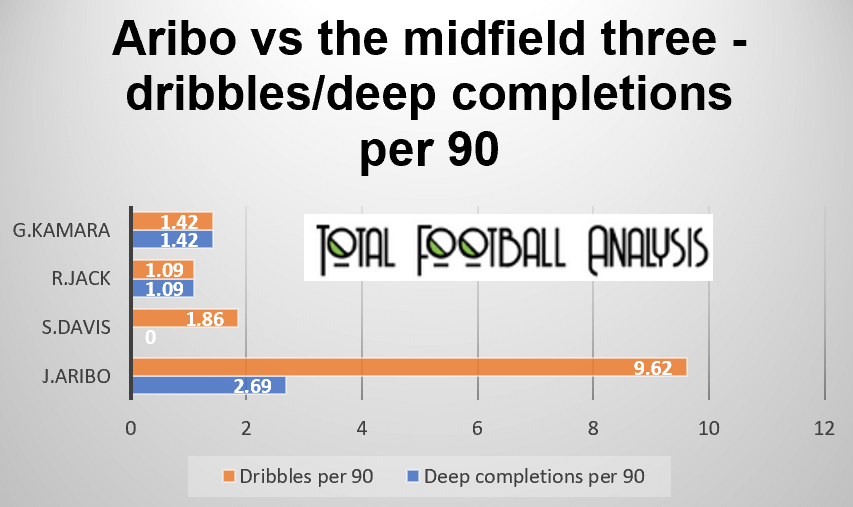
New signings – options in abundance
Morelos’ withdrawal from the Rangers squad for their 2-0 win against Kilmarnock is perhaps a sign of things to come. Strong interest has seen Morelos’ ‘head turned’ to quote Gerrard, which has seen Rangers secure the signings of Roofe and Itten to bolster their attacking options. So, what do they offer and how are they different to Morelos?
Roofe made a name for himself at Leeds United where he scored 29 goals and registered 11 assists, with the heart-breaking 4-3 aggregate defeat to Derby in the Championship Play Off semi-final his last contribution for the whites. Last season he was extremely injury prone and only managed to make 13 appearances for Anderlecht in the Belgian league. However, in those games, Roofe managed six goals and two assists and showed further signs of his attacking ability.
Roofe’s main qualities are ones that fit perfectly into Gerrard’s style of play. He is keen to press from the front, which is something that Gerrard favours but he also has the ability to drop deeper and link up the build-up play. This is something that will please Gerrard as it offers something different to what he already has and will provide Rangers with greater unpredictability against the low block. When analysing Roofe’s pressing and passing statistics, in comparison to Morelos, there are some interesting findings. In order to compare the efficiency of both players’ pressing, I have used interceptions per 90 as the metric, with forward passes per 90 the other comparative metric.
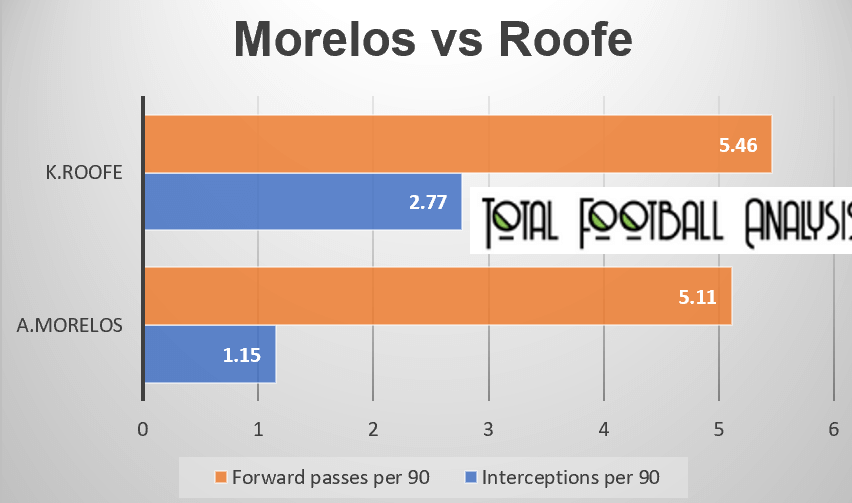
As you can see from the graph below, Roofe is better in both these categories. Roofe is far ahead in terms of interceptions and his counterpressing figures in general, yet the forward passes per 90 is relatively close. What we can conclude from this is that they are similar players that like to press and drop deep to build up the play. However, Roofe’s impressive figures indicate that if he can stay fit, he may just be as useful as Morelos for Rangers.
At 6 foot 2 inches, Itten provides a different option for Rangers. Itten is more than capable of playing a target man role but there is much more to his game than that. He scored 20 goals in 36 appearances for a St Gallen team that finished second in the Swiss league last season. Rangers recognised the gap in their attacking options for a taller striker to provide greater aerial strength but didn’t want someone that would completely change the approach. Itten is someone that looks like he can fit this billing and produce the goods for Rangers, alongside the likes of Roofe.
Like Roofe, we will compare Itten with last season’s most prominent striker Morelos. Itten is a lethal finisher in the box with many of his goals coming inside the box as a result of his clever and incise movement. To compare the two, we will look at touches in the penalty area, but also aerial duels won to show how Itten is able to offer Rangers something different to Morelos. The graph below plots these two metrics for the two players in last season’s campaign.
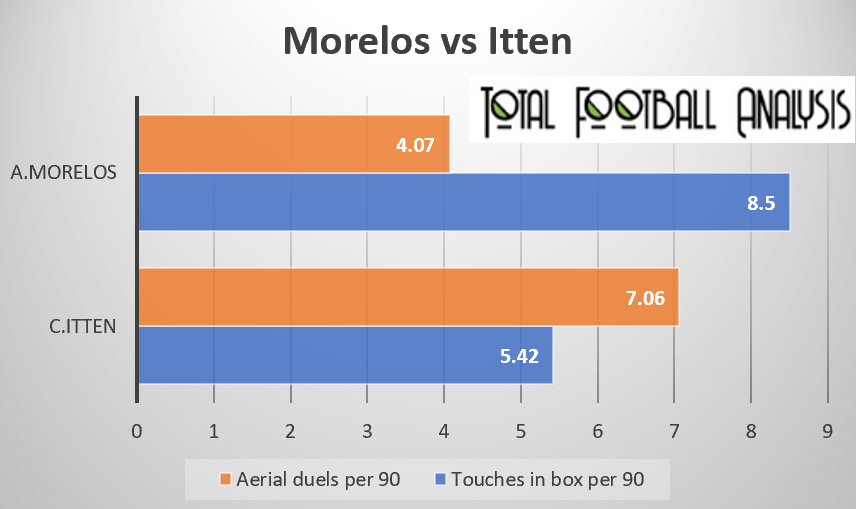
It is clear from this graph that Itten possesses an aerial ability far superior to Morelos. The fact he had nearly double the number of aerial duels than Morelos last year shows how his teammates were not afraid to play long to him throughout the season. It is also noteworthy that he is down quite significantly to Morelos on touches in the box per 90. Morelos’ 8.5 per 90 was the most in Rangers’ team last year and their overreliance on the Columbian was a stick that was used to beat Gerrard with. Itten’s touches in the box per 90 figures look average in comparison to Morelos’ numbers, yet if Itten was a Rangers player last year then his 5.42 touches in the box per 90 would have been the third highest in the entire squad.
Itten’s movement in the box and ability to find space was the hallmark of his goal scoring last season. The graphic below indicates the positioning of Itten’s shots in last season’s campaign and it is notable that all his goals came inside the box. Itten is lethal with cutbacks and ground passes fired into the box and the early signs from this season are the high and wide positioning of the full-backs, with an emphasis on cutting the ball back from the by-line, play to his strengths. Coupled with an aerial ability that is greater than Rangers’ current crop of strikers, Itten also looks to be an astute addition for The Gers.
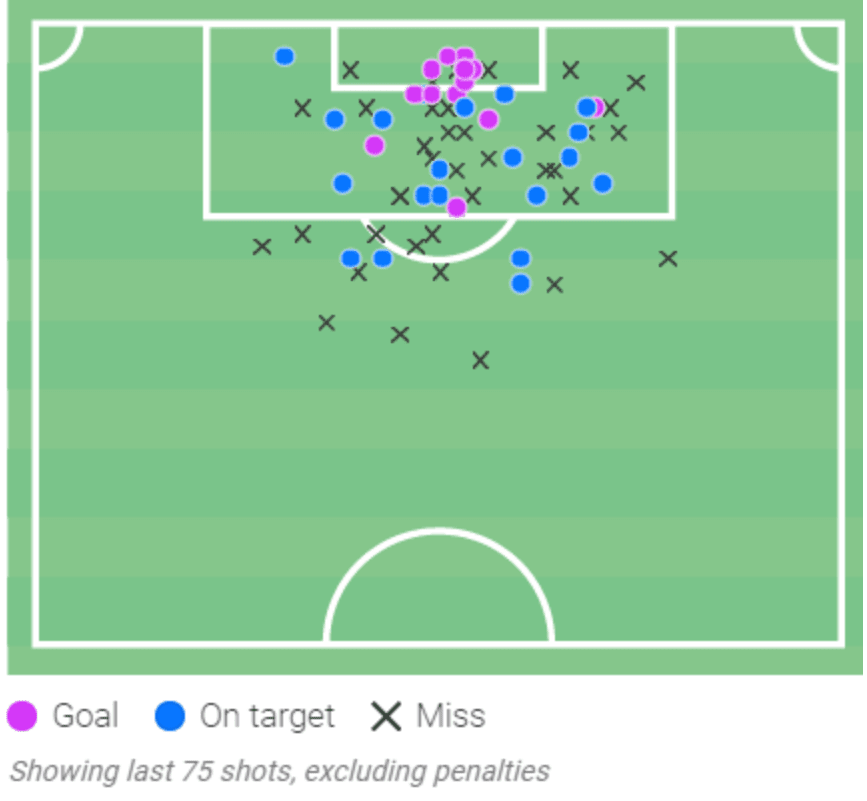
Conclusion
This data analysis has highlighted the reasons why Rangers look best placed to mount a title challenge for the first time under Steven Gerrard. Rangers and Gerrard are beginning to look like a team that is finding more solutions and becoming more unpredictable against the low block. This is due to a heavy focus on making their formation as flexible and fluid as possible to make their star players harder to mark in order to create greater spaces in attacking areas. Personnel such as Aribo and Kent are key to Rangers’ success, and the additions of Roofe and Itten look to be solid pieces of business, especially given the uncertainty surrounding the talisman of the last couple of years, Morelos. All this combined adds up to a team that looks to be adaptable and more unpredictable than ever, which can help Rangers cross the line in tighter games against teams that sit in and frustrate them with a low block. Although surpassing Celtic will be extremely tough, Rangers’ early season form suggests that the gap is quietly closing.





Comments